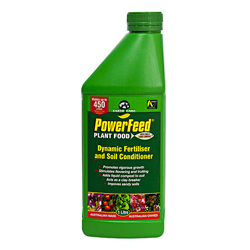By Darren (Plot 219)
We all like to give our plants a boost, and one product I’ve used – on the basis it was completely organic – was Powerfeed (by Seasol). To my surprise, I recently saw “Organic Powerfeed” (in a white container) in stores.
Had I been misinformed, or was Powerfeed not really organic? The only clue from the containers were different NPK levels.
So, to ensure I was (and had been) using an organic product, I contacted Seasol for the answer. Their response (reprinted with permission) was:
“Thanks for your query about the Organic status of Powerfeed. This is an important point that we like people to be clear about.
Seasol is certified Organic and Powerfeed is “Organic-based”. This means it is mostly made from certified Organic ingredients (such as our Fish emulsion), but it also has some added inorganic nutrients. Although this prevents Organic certification for our regular Powerfeeds we are careful to ensure there are no toxic ingredients or synthetic chemicals that could leave harmful residues, build up in the soil or damage the environment. Hence the reason for the new PowerFeed Organic product – as with Seasol, this meets all of the required standards for organic certification with Australian Organics (formally the Biological Farmers Association). You will still get very good results from the organic product however we would not expect it to perform as well as the other PowerFeeds due the lower NPK levels.”
So there you go. Powerfeed was organic-based, but in order to be officially certified as organic, they were required to modify the formula to ensure no inorganic nutrients were present.
I plan to switch to the organic-certified version, to be 100% sure and as a comparison, but regular Powerfeed is still safe to use on your plot as it does not contain synthetic chemicals.
Note: Price difference between a liter of Powerfeed vs Powerfeed Organic is about $2.5 less.

